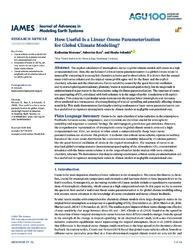How Useful Is a Linear Ozone Parameterization for Global Climate Modeling?
DOI: https://doi.org/10.1029/2019MS002003
Persistent URL: http://resolver.sub.uni-goettingen.de/purl?gldocs-11858/9465
Persistent URL: http://resolver.sub.uni-goettingen.de/purl?gldocs-11858/9465
Meraner, Katharina; Rast, Sebastian; Schmidt, Hauke, 2020: How Useful Is a Linear Ozone Parameterization for Global Climate Modeling?. In: Journal of Advances in Modeling Earth Systems, Band 12, 4, DOI: 10.1029/2019MS002003.
 |
Dokument öffnen: |
The explicit calculation of stratospheric ozone in global climate models still comes at a high computational cost. Here, the usefulness of a linear ozone parameterization in a global climate model is assessed by comparing it to an explicit chemistry scheme and to observations. It is shown that the annual mean total ozone column and the tropical ozone profile agree well for the linear and the explicit chemistry schemes and the observations. Ozone variability caused by the quasi-biennial oscillation and by extratropical quasi-stationary planetary waves is reproduced qualitatively, but its magnitude is underestimated in particular in the simulations using the linear parameterization. The response of ozone to a quadrupling of CO
2 simulated with both schemes is in the range of earlier simulations with explicit schemes. This concerns in particular ozone decreases in the tropical lower stratosphere and increases above predicted as a consequence of a strengthening of tropical upwelling and potentially affecting climate sensitivity. This study demonstrates that despite existing weaknesses a linear ozone parameterization can be a useful tool to represent stratospheric ozone in climate models at negligible computational cost.
Statistik:
ZugriffsstatistikSammlung:
This is an open access article under the terms of the Creative Commons Attribution License, which permits use, distribution and reproduction in any medium, provided the original work is properly cited.

